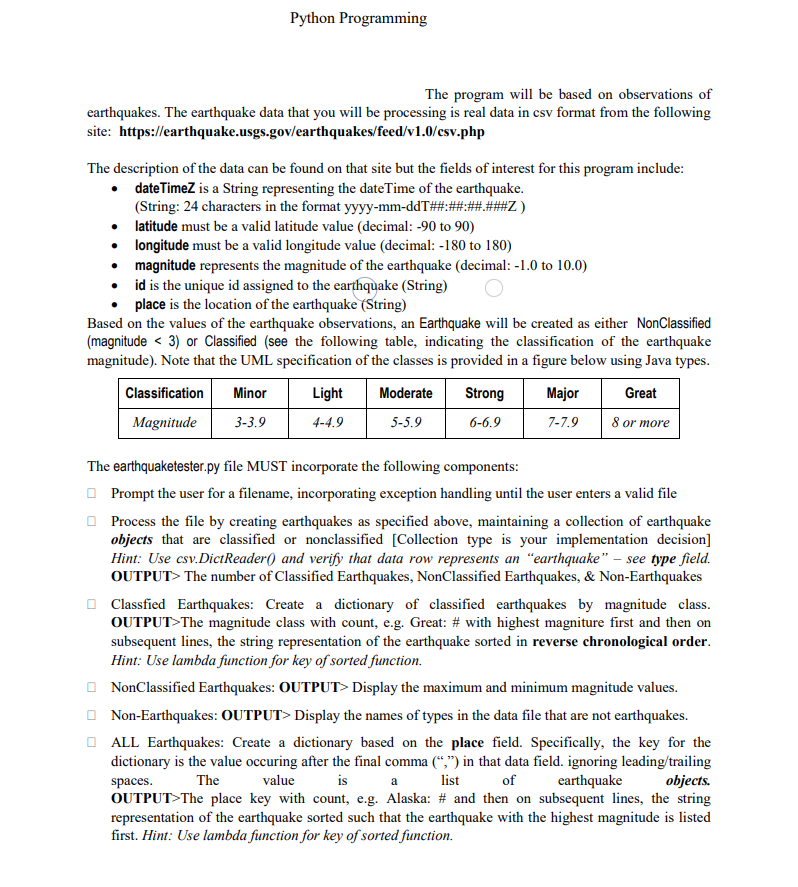Answered step by step
Verified Expert Solution
Question
1 Approved Answer
Can please someone help me with this in Python? I don't know where to begin. Thank you so much! I'd appreciate any help that you
Can please someone help me with this in Python? I don't know where to begin. Thank you so much! I'd appreciate any help that you could give.
website: https://earthquake.usgs.gov/earthquakes/feed/v1.0/csv.php



These UMLs are in Java format, but should be in Python.
Python Programming The program will be based on observations of earthquakes. The earthquake data that you will be processing is real data in csv format from the following site: https://earthquake.usgs.gov/earthquakes/feed/v1.0/csv.php The description of the data can be found on that site but the fields of interest for this program include dateTimeZ is a String representing the dateTime of the earthquake (String: 24 characters in the format yyyy latitude must be a valid latitude value (decimal: -90 to 90) longitude must be a valid longitude value (decimal: -180 to 180) magnitude represents the magnitude of the earthquake (decimal: 1.0 to 10.0) . . id is the unique id assigned to the earthquake (String) place is the location of the earthquake (String) . Based on the values of the earthquake observations, an Earthquake will be created as either NonClassified (magnitude The number of Classified Earthquakes, NonClassified Earthquakes, & Non-Earthquakes Classfied Earthquakes: Create a dictionary of classified earthquakes by magnitude class OUTPUT-The magnitude class with count, e.g. Great: # with highest magniture first and then on subsequent lines, the string representation of the earthquake sorted in reverse chronological order Hint: Use lambda function for key of sorted fiumction NonClassified Earthquakes: OUTPUT> Display the maximum and minimum magnitude values. Non-Earthquakes: OUTPUT> Display the names of types in the data file that are not earthquakes. ALL Earthquakes: Create a dictionary based on the place field. Specifically, the key for the dictionary is the value occuring after the final comma ("") in that data field. ignoring leading/trailing spaces OUTPUT-The place key with count, eg. Alaska: # and then on subsequent lines, the string representation of the earthquake sorted such that the earthquake with the highest magnitude is listed first. Hint: Use lambda function for key of sorted function. The valuesalist earthquakeobjects. Python Programming The program will be based on observations of earthquakes. The earthquake data that you will be processing is real data in csv format from the following site: https://earthquake.usgs.gov/earthquakes/feed/v1.0/csv.php The description of the data can be found on that site but the fields of interest for this program include dateTimeZ is a String representing the dateTime of the earthquake (String: 24 characters in the format yyyy latitude must be a valid latitude value (decimal: -90 to 90) longitude must be a valid longitude value (decimal: -180 to 180) magnitude represents the magnitude of the earthquake (decimal: 1.0 to 10.0) . . id is the unique id assigned to the earthquake (String) place is the location of the earthquake (String) . Based on the values of the earthquake observations, an Earthquake will be created as either NonClassified (magnitude The number of Classified Earthquakes, NonClassified Earthquakes, & Non-Earthquakes Classfied Earthquakes: Create a dictionary of classified earthquakes by magnitude class OUTPUT-The magnitude class with count, e.g. Great: # with highest magniture first and then on subsequent lines, the string representation of the earthquake sorted in reverse chronological order Hint: Use lambda function for key of sorted fiumction NonClassified Earthquakes: OUTPUT> Display the maximum and minimum magnitude values. Non-Earthquakes: OUTPUT> Display the names of types in the data file that are not earthquakes. ALL Earthquakes: Create a dictionary based on the place field. Specifically, the key for the dictionary is the value occuring after the final comma ("") in that data field. ignoring leading/trailing spaces OUTPUT-The place key with count, eg. Alaska: # and then on subsequent lines, the string representation of the earthquake sorted such that the earthquake with the highest magnitude is listed first. Hint: Use lambda function for key of sorted function. The valuesalist earthquakeobjectsStep by Step Solution
There are 3 Steps involved in it
Step: 1

Get Instant Access to Expert-Tailored Solutions
See step-by-step solutions with expert insights and AI powered tools for academic success
Step: 2

Step: 3

Ace Your Homework with AI
Get the answers you need in no time with our AI-driven, step-by-step assistance
Get Started


